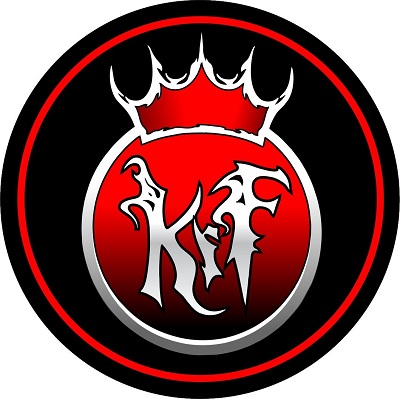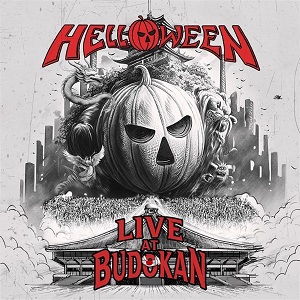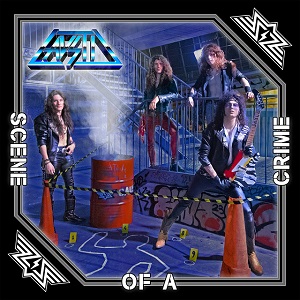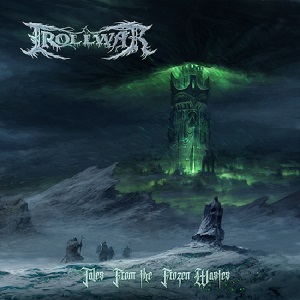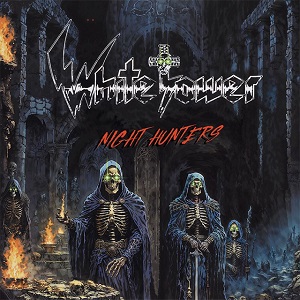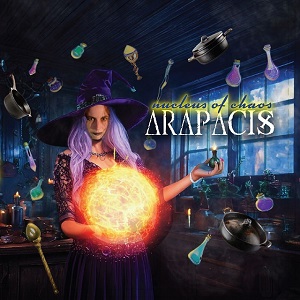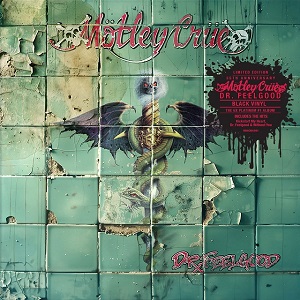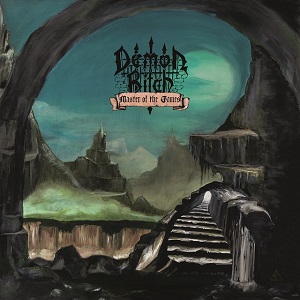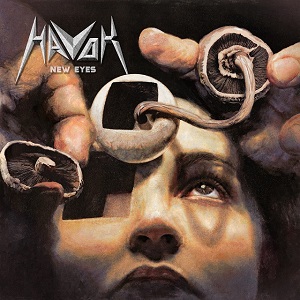RIOT’s Mark Reale: “Lars Ulrich From METALLICA In Their Tour Pamphlet, Wearing A Riot Shirt; It Does It For Me” - Narita At 35
October 5, 2014, 10 years ago
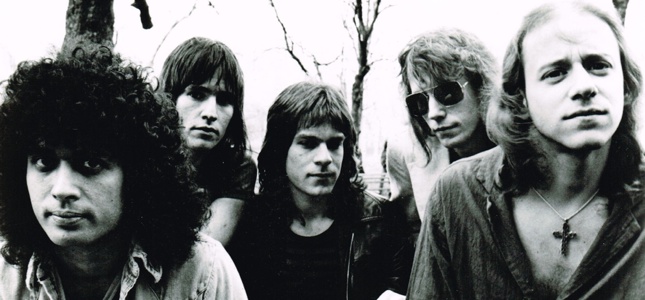
Crack a cold one, ‘cos today is the 35th birthday of Riot’s second album, Narita, a seminal metal classic that is not quite Fire Down Under, but a heaping dose of prescient, modern metal in advance of the New Wave Of British Heavy Metal all the same, given it’s October 5th, 1979 release date.
In this abridged version of the 18-page chapter from my book Ye Olde Metal: 1979, we celebrate the album that made Long Island, New York’s Riot an honourary member of the NWOBHM, along with the likes of Krokus, Accept, AC/DC, Y&T; and many loud ‘n’ proud others.
Riot leader and guitarist Mark Reale is not with us any more, having succumbed to the painful and debilitating effects of Crohn’s Disease on January 25, 2012, the after-story adding to the many reasons why the band never achieved the fame so due to them, namely that its leader was often incapacitated by pain. I had the pleasure of speaking with Mark a number of times over the years and always found him to be thoughtful, courteous, self-effacing, and endearingly in love with being a metalhead despite, for pleasure, listening to a wide variety of music.
It was indeed Mark’s versatility and love of many musical genres that helped infuse Riot with a magic touch that left so many of us scratching our heads at why they weren’t out there axe-battling it out with Van Halen for US rock supremacy through the heady heavy metal daze of the ‘80s.

Says Mark, articulating the alloy of silk and steel that was Riot, “The thing is, I don’t want to say it’s like ego or whatever, but I got involved with musicians that were incredible, so I knew that we could play fast; that’s always been the Riot thing from the beginning. But at the same time, I like pop music, man. The melodic aspect... it was the combination of those two things that I think created that whole vibe. Because you’ve got bands that can play their asses off, and play 100 miles an hour and it’s pretty much all it is, or you have bands that basically do pop-oriented stuff. The thing with Riot was, I combined the two elements of that. And I think that was the appeal to it. I like both aspects of it. I like the testosterone-driven guitar stuff, but at the same time, I’m very emotional, and I like to feel, I like melody, I want to feel melody. So I think it’s those two things that pretty much formulated the whole Riot thing.”
“The first three Riot records, you had Rock City, Narita and Fire Down Under, and we were still searching on Narita,” continues Mark, quite accurately, given the now only slight throwback to the ‘70s on this very heavy record for the ‘70s. “It’s like the third is the charm. The first record was like a bunch of kids from my basement in Brooklyn, New York, just doing whatever we did, and Narita was a little bit more formulated. It was kind of getting there, and I think I finally hit on it with Fire Down Under. Fire Down Under is more focused than the first two records, and I think we finally hit on it there. And then of course Guy Speranza left the band and the whole thing went into disarray (laughs), and I had to rediscover myself.”“So yeah, Narita is our second attempt, and as I say, we were still trying to find ourselves at that point. I think by the time we reached Fire Down Under, we had basically found our niche. The first record, Rock City, we were really green at that point. With Narita I think our songwriting just chilled a little bit more, and by the time we hit Fire Down Under, we pretty much had the concept down.”
Back to the transition between Rock City and Narita, perhaps some of the shift lies in the fact that Mark’s co-guitarist on the debut, LA Couvaris, was now gone, replaced by Rick Ventura.
“OK, LA was on the first record, Rock City, great guitar player, OK? Great guitar player. What basically happened was the first record we did, like me and Guy were like 18 years old and we signed contracts with these two crazy dudes, that basically produced those first three records. But to give them credit, they knew about marketing and focusing, and with LA it was like he was writing songs like Steve Miller. He was writing songs that were on a very straight rock/pop-oriented situation. Because I don’t know if you know, we had a keyboard player at that point. I was stumbling around. I didn’t know what was going on. The thing with LA was, he was a great guitar player, he was writing stuff, good songs, really good songs, but like I said, they were akin to something like Steve Miller or whatever. And the producers were like, ‘Look, this is what you need to do. You need to cut the keyboard player, you need to do guitar music, and this is the direction you should go in.’ And basically he kind of got cut out of it, because the stuff he was writing wasn’t... because we were moving more in a heavy direction. And to be honest about it, it was like our producers were controlling the situation at the time, and they were basically cutting him out. It’s like those songs may be OK, but that’s not the direction we’re going in. You’ve got to remember, around that time you had this whole thing going on with the New Wave Of British Heavy Metal, to coin a phrase, and that’s where they saw us going, and so he just kind of got bumped out of it.”Narita, again, issued October 5, 1979 (and actually five months earlier, in Japan) opens with a perfect example of hooky yet brisk modern metal called ‘Waiting For The Taking.’ Instantly, one is swept up into a froth of enthusiasm that this band could go places, much as one felt back at Montrose’s debut, (okay, more of an ‘I Got The Fire’ comparative) this track definitely evocative of that record’s sizzle and promise. Speranza is singing with authority, the band chemistry behind him is palpable, and it’s all captured in warm yet forward-thinking heavy metal high fidelity.
“Basically the whole style just came from the fact that there was just this amalgam of influences we had,” says Mark in agreement with that assessment. “I was heavily influenced by Ronnie Montrose and that first Montrose record. I was heavily influenced by that whole high energy kind of approach. We used to go see them in concert. And that was the model I had in my head. I was also into the European bands like Deep Purple and Rainbow, so from my end, it was the heavy guitar kind of thing. Guy Speranza was more into bands like Thin Lizzy, more of a pop thing. And when it came together, Riot is pretty much what came out. You had this very guitar-driven music with this melodic vocal on top. So we were pretty much just feeling our way through on those first two records. I don’t think it was until Fire Down Under that we pretty much nailed our sound.”

And yet there was no problem capturing a huge stadium rock sound, right there on Narita, and arguably on much of the less even Rock City.
“It was all pretty much experimental,” says Mark on the fortuitous and even lucky knob-jobbing on those early Riot records. “Steve had his own ideas about what the deal would be. As far as production goes, we were pretty much just following. We really didn’t have a lot of control at that time other than writing material. We’d go write the songs and we played them. But as far as the studio went, we were pretty naive. When we did Rock City, and even on into Narita, we had no idea what we were doing in a sense. We had no idea of a concept. To Steve’s credit, because we were really young, we were coming in there with heavy metal songs, we had pop songs, rock songs, we were coming in with all sorts of things. And you can hear it on Rock City. There was no real solid definitive direction at that point, and I think during those first two records, we were trying to feel our way through what we were doing. And I think Narita was just the second step in that. It was a little more solidified in terms of concept than Rock City.”“I guess we pretty much built it,” laughs Reale, with regard to where Narita was recorded, Big Apple Studios in New York City. “Basically, it was these two dudes that owned it, and during the course of our progression there, I mean, when we first went there, it was a 16-track analog studio, a little studio, and then by the time we got to Fire Down Under, it was like a 24-track analog studio, and by the time we got to Thundersteel it was like digital. The whole thing progressed. But at the same time, that studio was doing a lot of hip-hop and rap stuff. A lot of people don’t know that I played... I did a lot of session work at one point. The early ‘80s, I played on a lot of hip-hop stuff, with friggin’ Flavor Flav, because at that point, ever since the Michael Jackson/Eddie Van Halen thing, a lot of hip-hop stuff at that point wanted rock guitar players on their records. Run D.M.C., they were out of there, and I forget the guitar player’s name who played on those records, but that became the thing there, and nobody knows that. You know, like I was on motion pictures, like Breakin’ and stuff, because a lot of those artists wanted rock guitar players, and there was a little stretch of period where I did a lot of session work that nobody knows about. But I remember that studio. Run D.M.C. was a big thing out of there, and as for where that came from, man, with the heavy guitar over the rap stuff, they did a lot of that stuff there, including Public Enemy.”
Closing side two of the original vinyl is the title track, a ripping instrumental that full-on finds these Americans in New Wave Of British Heavy Metal mode, unwittingly helping to invent speed metal, even adding the twin riffing found with Priest and soon-to-be NWOBHM flagship band Iron Maiden. The tie-in with Japan, from the title Narita through to the sumo stance of the seal mascot and the Japanese script on the cover, would prove beneficial for the band, as Mark quickly found himself set up with relationships with Japanese labels that would persist nicely through all the years we had Riot with us.
“Actually, our producers had something to do with that,” says Mark, concerning the use of the name Narita, from the city that contains the airport of the same name, the main air hub for the city of Tokyo. “If you look at the album cover… Narita’s the Japanese airport. And supposedly the story is that it was built on sacred ground, and there were protests going on at one point, because they built it on some kind of sacred ground and people were buried there and stuff. So it was our producer that came up with the idea. They didn’t write the song, but at the time, we were also starting to get rumblings that we had some kind of popularity in Japan. So it was kind of like a nod towards Japan, basically. Although at the time we made Narita, we hadn’t been to Japan yet. But we were getting rumblings from the magazines and the press and stuff, because there was a song we had called ‘Warrior,’ OK? And there was a female Japanese artist who covered it. I forget what it’s called (laughs). In English it was different words, and it was ‘Warrior’—that was the name of the song—but I think it was ‘Bye Bye Boy’ or something. And she covered it, and we were starting to get the impression that we had some degree of popularity there, at that point.”

When Narita hit the street, both band and new label, Capitol, were hopeful. “We put out Rock City on an independent label in the US and signed to major labels overseas,” said Guy, quoted in Narita’s press materials. “We got great reviews, began gigging all over the US, going on tour with Sammy Hagar, AC/DC and Molly Hatchet, playing 15,000-20,000 seaters. It blew our minds when audiences thousands of miles from Brooklyn shouted out the names of our songs.” Added Mark, gamely, “We are loud, we’re powerful, a lot of running around, visual, but without too much smoke-bombings and things.”
A Narita highlight is raucous album closer “Road Racin’,” a classic speed metal maven of gigantic proportions. “I remember ‘Road Racin’’ was a milestone,” says Mark. “I came up with that song, and when we first went into the studio with it, it totally clicked. And it was like, we’ve got to do more of that. There wasn’t a whole lot of pretense there with what I did. A lot of the stuff that I did was just like knee-jerk reaction, whatever came out of me. But ‘Road Racin’,’ I can definitely remember bringing that into the studio and recording that, and everybody going, ‘Yeah, this is good, this is cool.’ And at that point, you’re still finding yourself. And that’s why, like I said, at the point we did Fire Down Under, we finally hit the niche in terms of focus. If you listen to the first two records, you can hear, especially the first one, there’s a little bit here and there, but when you get to Fire Down Under, it’s focused. That’s where the band was coming from.”
“Road Racin’” is a blazing rock finale to an album that somewhat unjustly lives in the shadow of Fire Down Under. Indeed in some ways, Narita is more remarkable than its illustrious follow-up, given its crafting and execution a year before a newly modern metal became a norm. Sure, credit must go to Van Halen as perhaps the first band to wake hard rock up after a long and slow decline into the recline of a cozy nap, but Riot has to be your first asterix band when viewing the trajectory toward the heavy ‘80s.“In spite of the problems,” reflects Reale, in closing, “all the music we made and got out there, it got us enough fans that we can go and have this cult fan thing going on, and they stayed loyal. I’m shocked, because I couldn’t believe... this whole tour we’re going to do in October, November, it’s like Hammerfall demanded the promoter to put us on the tour. And to me that’s like friggin’… recording our music, that’s like so cool, man. To be able to influence other artists. That’s why I’m sitting here talking to you (laughs). We can still do this because, whatever music we made and got out there, was strong enough. We established this fan base that—and not only fans, but with other musicians, like Motley Crue, Hammerfall, Metallica—that we’re able to do this. I look at Lars Ulrich from Metallica in their tour pamphlet, wearing a Riot shirt—it does it for me. In spite of the mistakes I made, and how naïve I was and whatever went on, that does it for me. The wheels have definitely stayed, man (laughs). But it was great. To be honest with you, man, I can’t complain. I’ve toured the world, I don’t know how many times over, I’ve had great experiences. It is just what it is. Just to be able to affect, not only the fans, but other musicians, it means the world to me.”
As mentioned, the full 7,000 word story of Narita can be found in Ye Olde Metal: 1979, available from martinpopoff.com, the book also explaining records from that year by Motorhead, Hounds, Whitesnake, New England, Streetheart, Blackfoot, City Boy, Legs Diamond, Nazareth, Foreigner, Bad Company, TKO, Triumph, April Wine and Teaze.

